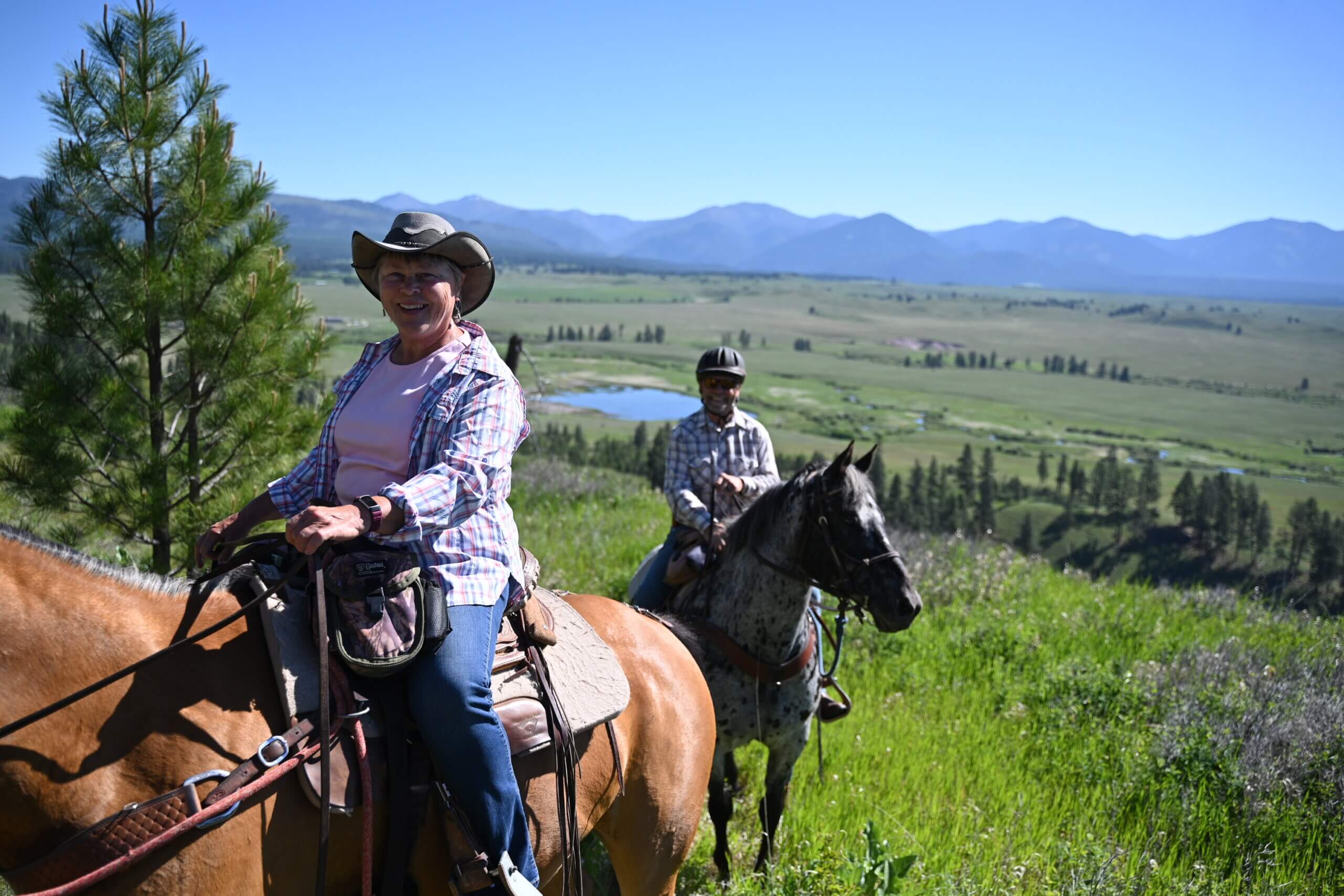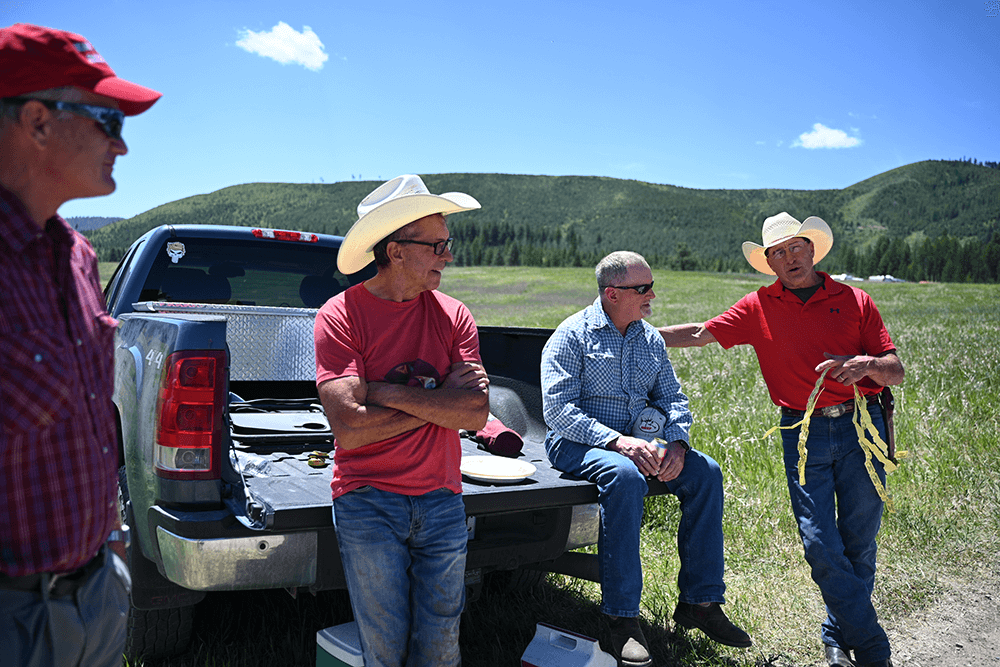by Vivien Felker (originally published in the November-December 2024 issue of Bugle magazine)
Horsemen and women gathered in western Montana in June to support elk country and celebrate one of the state’s most important wildlife management areas.
As the sun heated the south-facing hillsides, tall bouquets of arrowleaf balsamroots added bright yellow splashes to the spring splendor. Well-worn game trails etched by countless generations of elk climbed toward a ridge from the timbered draws below, now trodden by a herd of another four-legged creature: Horses.
I guided my borrowed gelding, Raven, behind the line of fellow Rocky Mountain Elk Foundation supporters as we rode across the Blackfoot-Clearwater Wildlife Management Area (WMA), located near the town of Seeley Lake, Montana.
A checkerboard of state and federal lands known to locals as simply “The Game Range,” this nearly 30,000-acre jewel surrounds the southwest corner of the Bob Marshall Wilderness Complex. Closed to all humans from December 2 to May 15, it serves as a vital winter hideout and life preserver for thousands of elk and deer after snow buries the high country. Come fall it also offers opportunities for elk and deer hunters.  But it wasn’t always a contiguous piece of public ground. For decades, conservation groups including RMEF have worked with Montana Fish, Wildlife & Parks (FWP) and other agencies to protect this critical haven. It all started 75 years ago when FWP bought the 11,000-acre Boyd Ranch in 1949, a historic working cattle and sheep operation. The purchase conserved a key slice of the historic wintering grounds for one of Montana’s most storied migratory elk and mule deer herds while also helping keep them off of nearby ranchers’ fields.
But it wasn’t always a contiguous piece of public ground. For decades, conservation groups including RMEF have worked with Montana Fish, Wildlife & Parks (FWP) and other agencies to protect this critical haven. It all started 75 years ago when FWP bought the 11,000-acre Boyd Ranch in 1949, a historic working cattle and sheep operation. The purchase conserved a key slice of the historic wintering grounds for one of Montana’s most storied migratory elk and mule deer herds while also helping keep them off of nearby ranchers’ fields.
Bit by bit, FWP added acreage over the decades, with the help of RMEF on three additional purchases to add some 5,500 additional acres to the WMA, and enhanced another 70,000 acres of habitat across the surrounding Blackfoot watershed through 70 stewardship projects.
The WMA is a popular destination for hunters, hikers and shed hunters, but local outfitter Jack Rich and RMEF volunteer Todd Johnson saw an opportunity to create an event on the property that would appeal to horsemen and women and fill the coffers for more conservation work in the process.
In 2001, their idea materialized into horses traversing the WMA as part of an RMEF fundraiser. Riders have flocked there every year since on the second Saturday of June to see the country from horseback while raising money for a good cause. Besides the sheer joy of the ride itself, Todd says it provides a great opportunity for participants to get out on terrain that helps prepare their horses for the rigors of the backcountry during a time when a lot of the high country is still snowed in.
Riders pay a small registration fee (just $45 this year) to follow a carefully laid path that Todd and his friend Paul Holmes change up each year. Pink flags tied to trees mark the way through high and low country. No trails are cleared to maintain the wild character of the WMA, making some areas a tight squeeze as we rode our horses in between dense firs.  This year’s route ran for roughly 8 miles starting and ending at the old Boyd Ranch. We stopped five times along the way to draw numbers from bags that we added to scorecards. Volunteers manned these checkpoints, many of whom had participated in the ride for many years before stepping up to become the support team. We all hoped to draw numbers that resulted in the highest (or lowest) score—or one that split the middle. If we got lucky, we’d be coming home with more than just sore legs. Prizes for the winning scores ranged from a slick RMEF-logoed pistol to horse tack.
This year’s route ran for roughly 8 miles starting and ending at the old Boyd Ranch. We stopped five times along the way to draw numbers from bags that we added to scorecards. Volunteers manned these checkpoints, many of whom had participated in the ride for many years before stepping up to become the support team. We all hoped to draw numbers that resulted in the highest (or lowest) score—or one that split the middle. If we got lucky, we’d be coming home with more than just sore legs. Prizes for the winning scores ranged from a slick RMEF-logoed pistol to horse tack.
Todd says many riders arrive unaware of the mission of RMEF, but soon find not only adventure but a front-row seat to what the foundation works so hard to conserve. “The ride brings in a different group of people that may or may not attend a banquet,” he says. “We leave it open to anyone, and they don’t have to spend a ton to attend.” 